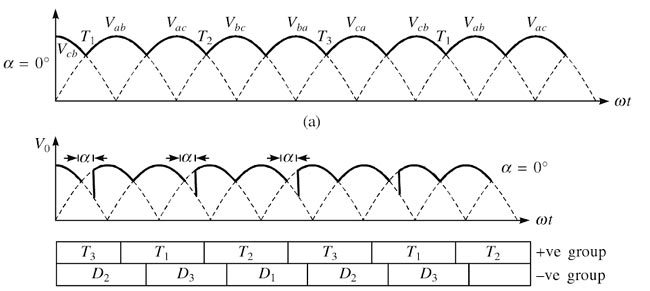In a 3-φ semi converter for firing angle less than or equal to 60°, wheeling diode conducts for
Right Answer is:
Zero degree
SOLUTION
The three-phase semi-converter is shown in the figure. The thyristor T1 receives the gate pulse and conducts from (30° + α) to 150°, thyristor T2 will conduct from (150° + α) to 270°, and thyristor T3 conducts from (270° + α) to 390°.
![]()
The semi-converter bridge operation for different angles is shown in the form of voltage and current waveforms, and its conduction angles for the SCRs, diodes and freewheeling diode are also shown in Fig(a). For the firing angle α = 0, T1, T2 and T3 would behave as diodes, and the voltage of semi-converters would be asymmetrical six-pulse for each cycle as shown in Fig. (a). The output voltage consists of pulses Vab, Vac, Vbc, etc. as shown in Fig. The triggering of the thyristors T1, T2 and T3 are delayed but return diodes D1, D2 and D3 remain unaffected so that alternate pulses are altered. The load current is continuous and has a little ripple. The forward diode does not come into play for α = 15°, and each SCR and diode conducts for 120°.
In Fig. VCb is the load voltage from = 0° to 60°, as the first subscript indicates conduction in the positive group, voltage VCb, that T3 is already conducting through diode D2 of the negative group. Voltages Vab and Vac, according to the first subscript, conduct for 120° and begin to conduct at ωt = 60° for α = 0 as shown in Fig. Similarly, Vbc and Vca indicate that T2 conducts for 120° and it begins to conduct at ωt = 180° for α = 0. The thyristor with α = 0 behaves like a simple diode; therefore the thyristor T1 conducts for ωt = 60°, ωt = 180° for T2, ωt = 300° for thyristor T3, and so on.

For ωt = 60° as shown in waveform the thyristors are triggered so that the current returns through one diode for each conduction period of 120° for voltage Vac. T1 and D3 conduct simultaneously for 120° as shown in Fig.c. The situation is similar for the other elements. The freewheeling diode doesn’t exist for its conduction even for α = 60°; therefore, the voltage pulses Vab, Vbc, and Vca do not appear in the output waveforms. For α = 60°, therefore, the load current is assumed to continue for α = 60°.

For firing angle ωt = 90°, output voltage VO is discontinuous. As VO tends to become negative at ωt = 120°, 240°, 360°, the freewheeling diode (FD) gets forward-biased there for each periodic cycle of 120°. The output voltage is equal to the supply voltage. When FD conducts, VO = 0 for α = 90°, the conduction angle of SCR and diodes is seen to be less than 120° for every output pulse. Voltage pulses Vab, Vbc, and Vca provide output voltage VO for this firing angle as well. Without a freewheeling diode, after load voltage VO reaches zero, a diode from the negative group would become conducting, reducing VO to zero till the next thyristor from the negative group starts conducting.

Conclusion:- A freewheeling diode is added across the load to conduct the load current during the negative half cycle and prevent it from being reduced to zero. Since in 3-phase semi converter conduct for 120° therefore till firing angle “α” 60° the freewheeling diode will not work.
